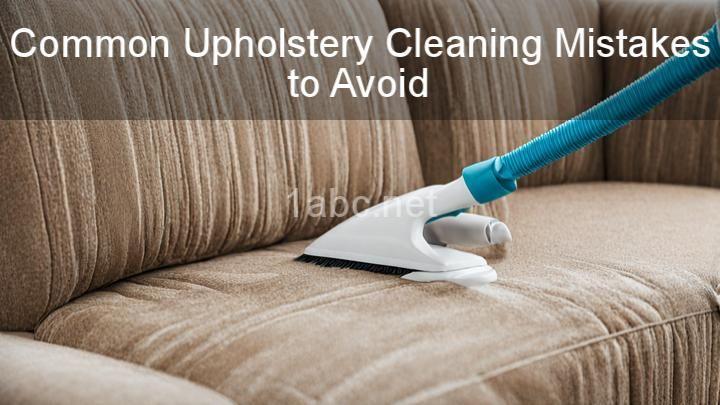Common Upholstery Cleaning Mistakes to Avoid

Introduction:
Hello, upholstery enthusiasts! We can all agree that clean and fresh upholstery is a delight to the senses. Whether it's your favorite couch, dining chairs, or beautiful armchairs, we want our upholstered furniture to look its best. But do you know the right way to clean and maintain it? In this blog post, we will explore the common mistakes to avoid when it comes to upholstery cleaning. By steering clear of these blunders, you can ensure that your furniture not only remains beautiful but also lasts for years to come.
I. Skipping Regular Vacuuming:
One of the most common mistakes people make when it comes to upholstery cleaning is skipping regular vacuuming. Vacuuming is not just for carpets; it plays a crucial role in removing loose dirt, dust, and debris from upholstery as well. Neglecting this step can lead to deep-set stains and a buildup of allergens over time. To keep your upholstery in prime condition, it is recommended to vacuum it at least once a week. Be sure to use the appropriate attachments to reach every nook and cranny.
II. Using Harsh or Incorrect Cleaning Products:
Using harsh chemicals or improper cleaning solutions can cause significant damage to different types of upholstery fabrics. It's essential to educate ourselves about the potential risks and choose cleaning products wisely. Opt for gentle, pH-neutral cleaners specifically designed for upholstery. They are formulated to be effective yet safe for various fabric types. Additionally, always spot test any new product on a hidden area before applying it to the entire piece to avoid any unwanted surprises.
III. Scrubbing Vigorously:
When faced with a stubborn stain on our upholstery, it's tempting to scrub vigorously to remove it completely. However, this can do more harm than good. Excessive scrubbing can harm delicate fibers, causing them to fray or discolor. Instead, adopt a gentle approach when tackling stains. Use blotting and dabbing motions with a clean cloth or sponge to absorb the stain. This method is not only effective but also prevents further damage to the fabric. In case of tough stains, try using mild soap solutions or specialized stain removers specifically designed for upholstery.
IV. Over-wetting the Fabric:
Over-wetting upholstery fabric during the cleaning process can have several adverse effects. It can lead to prolonged drying times, watermarks, or even the growth of mold. To avoid these issues, it is crucial to find the right balance between sufficient moisture for effective cleaning and avoiding excessive wetness. Opt for appropriate tools, such as microfiber cloths, which are highly absorbent and help control moisture. Alternatively, consider using low-moisture extraction methods that offer better control over the amount of moisture applied.
V. Neglecting Professional Help:
While DIY upholstery cleaning can be effective for routine maintenance, there are situations where professional intervention is necessary. Stubborn stains, delicate fabrics, or valuable furniture may require the expertise of professional upholstery cleaners. It's essential to know our limits and recognize when it's time to call in the professionals. By doing so, we can protect our furniture and ensure it receives the specialized care it deserves. When seeking professional help, be sure to select reputable and experienced cleaning services that prioritize the preservation of your upholstery.
Conclusion:
In conclusion, avoiding common upholstery cleaning mistakes is vital for maintaining the beauty and longevity of your furniture. By regularly vacuuming, using appropriate cleaning products, adopting gentle stain removal techniques, avoiding over-wetting, and knowing when to seek professional help, you can keep your upholstery cleaner, fresher, and longer-lasting. So, next time you clean your upholstery, remember these tips and enjoy the satisfaction of a job well done. We would love to hear about your own experiences and answer any questions in the comments below. Happy cleaning!
FREQUENTLY ASKED QUESTIONS
What are common upholstery cleaning mistakes?
Common upholstery cleaning mistakes include:
- Using excessive water: Applying too much water can soak the upholstery and lead to mold or mildew growth. It is important to use the right amount of water for effective cleaning.
- Not testing cleaning products: Failure to test cleaning products on a small, inconspicuous area can result in damage to the upholstery. Always test any cleaning solution on a hidden spot before applying it to the entire surface.
- Scrubbing too aggressively: Scrubbing vigorously can damage the fabric and cause it to fray or discolor. Instead, gently blot or pat the stain to lift it without causing further damage.
- Using inappropriate cleaning solutions: Using the wrong cleaning solution can harm the upholstery fabric. It's crucial to read the manufacturer's instructions and choose a cleaning product specifically designed for your upholstery type.
- Neglecting to vacuum first: Skipping the initial vacuuming can push dirt, dust, and debris deeper into the fabric. Vacuuming helps to remove loose particles before applying any cleaning solution.
- Ignoring care labels: Each upholstery fabric comes with care instructions. Ignoring these labels can result in irreversible damage. Make sure to follow the care instructions provided by the manufacturer.
- Not allowing proper drying time: Allowing the upholstery to dry completely is essential. Failing to do so can create a damp environment that promotes mold growth.
- Overlooking professional cleaning: While regular DIY cleaning is important, professional upholstery cleaning is necessary to maintain the longevity and appearance of the furniture. Professional cleaners have specialized equipment and expertise to deep clean and restore upholstery effectively.
How can these mistakes damage my upholstery?
Mistakes can potentially cause damage to upholstery in several ways:
- Using the wrong cleaning products: Using harsh or abrasive cleaning products that are not suitable for the specific type of upholstery can lead to discoloration, fading, or even permanent stains.
- Scrubbing too forcefully: Aggressively scrubbing upholstery can cause the fabric to fray or become worn out. It is important to use a gentle touch when cleaning to avoid damaging the fibers.
- Over-wetting the fabric: Excessive moisture during the cleaning process can result in mold or mildew growth, which can permanently damage the upholstery. It is important to use the appropriate amount of water or cleaning solution and to ensure proper drying afterwards.
- Ignoring stains and spills: Neglecting to address stains or spills on upholstery in a timely manner can lead to the stain setting in and becoming more difficult to remove. This can result in permanent stains or discoloration.
- Not following manufacturer's instructions: Failing to follow the recommended cleaning guidelines provided by the manufacturer can lead to unintended consequences and potential damage. It is important to carefully read and adhere to the instructions specific to your upholstery.
By avoiding these mistakes and taking proper care of your upholstery, you can help maintain its appearance and prolong its lifespan.
How often should I clean my upholstery?
Cleaning frequency for upholstery depends on various factors such as usage, the presence of pets or children, and personal preferences. However, as a general guideline, it is recommended to clean your upholstery at least once every 6-12 months. Additionally, regular maintenance, such as vacuuming or spot cleaning, can help extend the time between deep cleanings. Remember to always check the manufacturer's instructions and recommendations for cleaning your specific type of upholstery.
Can I use regular household cleaning products on upholstery?
Regular household cleaning products can generally be used on upholstery, depending on the type of fabric and the specific cleaning product. It is important to check the manufacturer's instructions for your upholstery to determine what cleaning products are recommended or safe to use. Some upholstery fabrics may require specialized or gentle cleaning agents to avoid potential damage. It is also a good idea to do a patch test on a small, inconspicuous area of the upholstery before applying any cleaning product to the entire surface.

